TPN and Its Effect on Immune Function in Critically Ill Patients
Understanding the Role of TPN in ICU Patient Recovery
Total Parenteral Nutrition (TPN) is a vital intervention for critically ill patients unable to meet their nutritional needs through enteral routes. Its influence extends beyond mere nutrient delivery, notably affecting immune system dynamics. This article delves into how TPN impacts immune function, associated risks, and clinical considerations to optimize patient outcomes.
General Guidelines for TPN Dosing and Administration
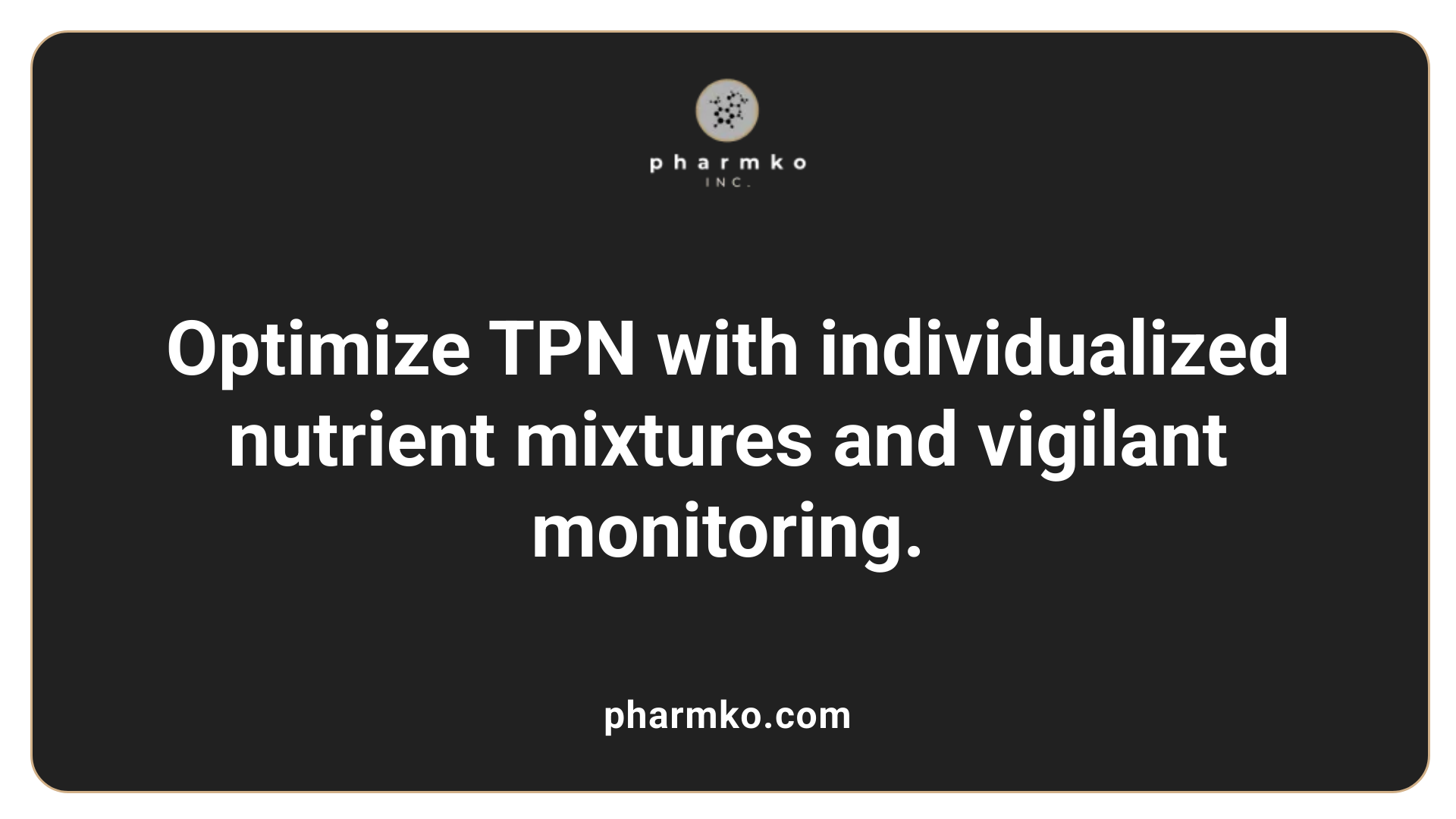 Total parenteral nutrition (TPN) is a vital intervention for critically ill patients who cannot meet their nutritional needs through enteral feeding. Proper dosing and administration of TPN are essential to maximize benefits and minimize risks.
Total parenteral nutrition (TPN) is a vital intervention for critically ill patients who cannot meet their nutritional needs through enteral feeding. Proper dosing and administration of TPN are essential to maximize benefits and minimize risks.
Tailoring nutrient mixtures to individual patient needs is the first step. The composition should include appropriate amounts of amino acids, lipids, and dextrose, calibrated according to the patient's metabolic demands, weight, and clinical condition. For example, protein requirements typically range from 1.2 to 1.5 grams per kilogram of body weight per day, supporting immune function and tissue repair.
Adjusting electrolyte and mineral supplies is equally important. Electrolytes such as sodium, potassium, magnesium, and calcium should be individualized based on daily laboratory results and ongoing assessments. Frequent monitoring allows clinicians to avoid imbalances, which can lead to complications like arrhythmias, neuromuscular problems, or metabolic disturbances.
Monitoring through laboratory tests is critical for safe TPN management. Regular checks of serum electrolytes, liver and renal function, blood glucose, and serum proteins help guide appropriate adjustments. Blood glucose levels should be maintained below 180 mg/dL for optimal outcomes, as hyperglycemia can impair immune function and increase infection risk.
Proper administration techniques involve using central venous access devices, such as peripherally inserted central catheters (PICCs) or tunneled catheters. Strict aseptic protocols must be followed to prevent infections. Solutions should be prepared with sterile procedures, filtered using micron filters to eliminate particulates, and protected from light when necessary. Additionally, infusion rates should be carefully controlled and titrated based on patient tolerance and metabolic response.
Guidelines from established organizations like the American Society for Parenteral and Enteral Nutrition (ASPEN) emphasize the importance of individualized therapy. Clinicians should tailor nutrient formulations, monitor patients vigilantly, and adjust therapy based on evolving clinical and laboratory data. Prompt recognition of complications—such as metabolic disturbances, infections, and vascular problems—is necessary to ensure safe and effective TPN use.
In summary, the main principles involve customizing nutrient composition, vigilant monitoring, meticulous administration practices, and adherence to standardized guidelines to optimize patient outcomes in critical care settings.
The Role of TPN in Critical Care Management
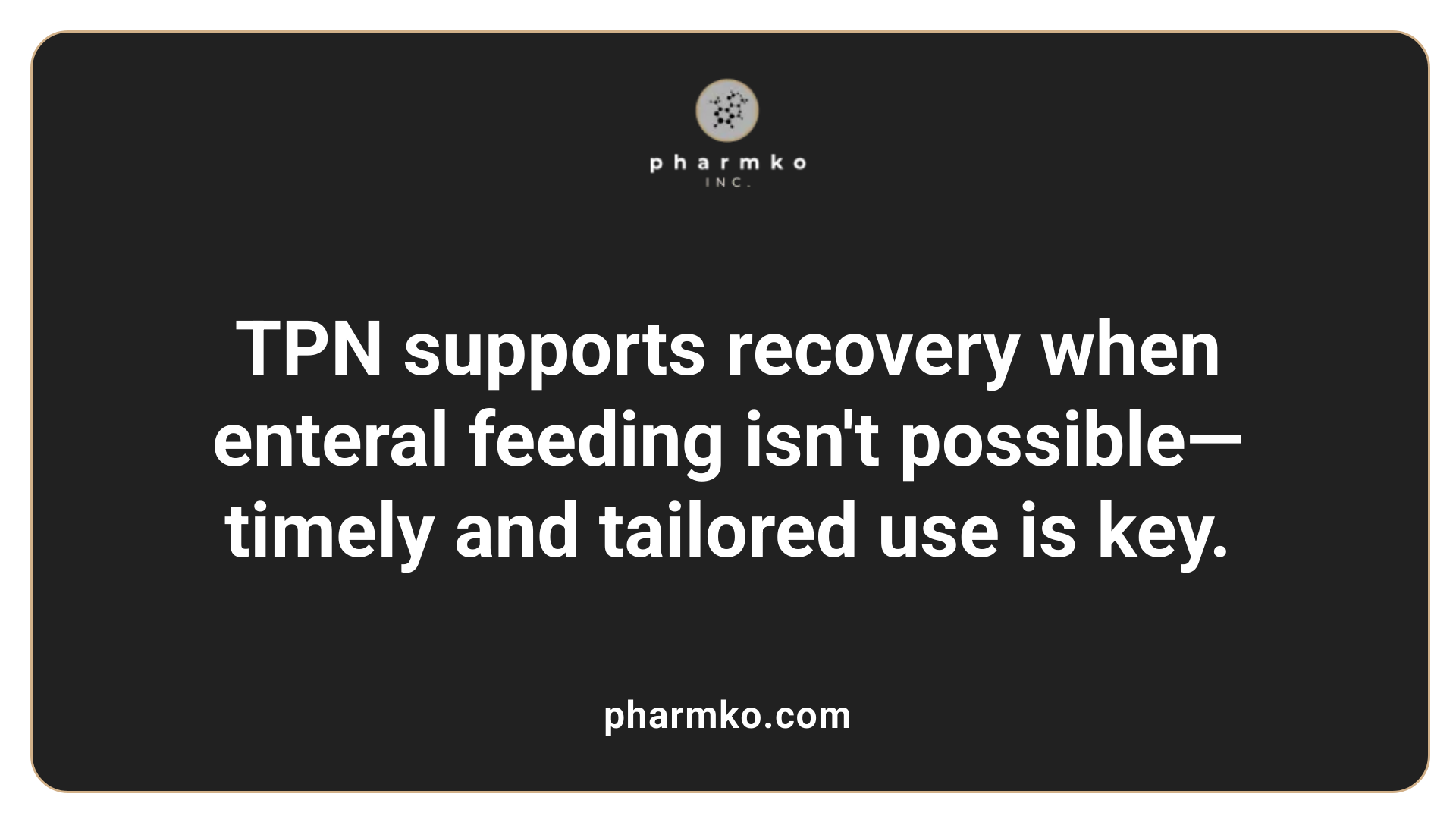 Parenteral nutrition, particularly total parenteral nutrition (TPN), is an essential aspect of supporting critically ill patients who are unable to receive adequate nutrition through the gastrointestinal (GI) tract. Such situations include gastrointestinal obstructions, extensive bowel resections, or severe fistulae with high output. In these cases, TPN provides a vital supply of nutrients, including amino acids, carbohydrates (dextrose), lipids, vitamins, and minerals.
Parenteral nutrition, particularly total parenteral nutrition (TPN), is an essential aspect of supporting critically ill patients who are unable to receive adequate nutrition through the gastrointestinal (GI) tract. Such situations include gastrointestinal obstructions, extensive bowel resections, or severe fistulae with high output. In these cases, TPN provides a vital supply of nutrients, including amino acids, carbohydrates (dextrose), lipids, vitamins, and minerals.
The primary purpose of TPN in ICU settings is to support immune response, promote tissue repair, and maintain muscle mass, all crucial for recovery. It ensures cellular functions and organ integrity are preserved when enteral nutrition is not possible or insufficient. Proper management involves careful monitoring of blood glucose levels, infection control, and adjusting nutrient composition based on individual metabolic needs.
Compared to enteral nutrition, TPN has the advantage of reliable nutrient delivery regardless of gut function. However, it also carries risks such as bloodstream infections, hyperglycemia, and metabolic disturbances.
Timing for initiating TPN usually depends on patient condition. It generally begins within 3 to 7 days if enteral feeding cannot meet nutritional requirements. The duration of TPN varies, lasting until the patient can tolerate enteral feeding or achieves adequate oral intake.
Recent studies indicate that when used appropriately, TPN can improve immune parameters, support tissue regeneration, and reduce complications related to malnutrition. Moreover, modern formulations with lipid emulsions and micronutrient supplementation further optimize immune function while minimizing adverse effects.
In summary, TPN plays a supportive role in critical care by bridging nutritional gaps, especially when gastrointestinal routes are compromised. Its proper application helps improve clinical outcomes, recovery times, and overall patient survival.
Risks and Side Effects of TPN: A Clinical Perspective
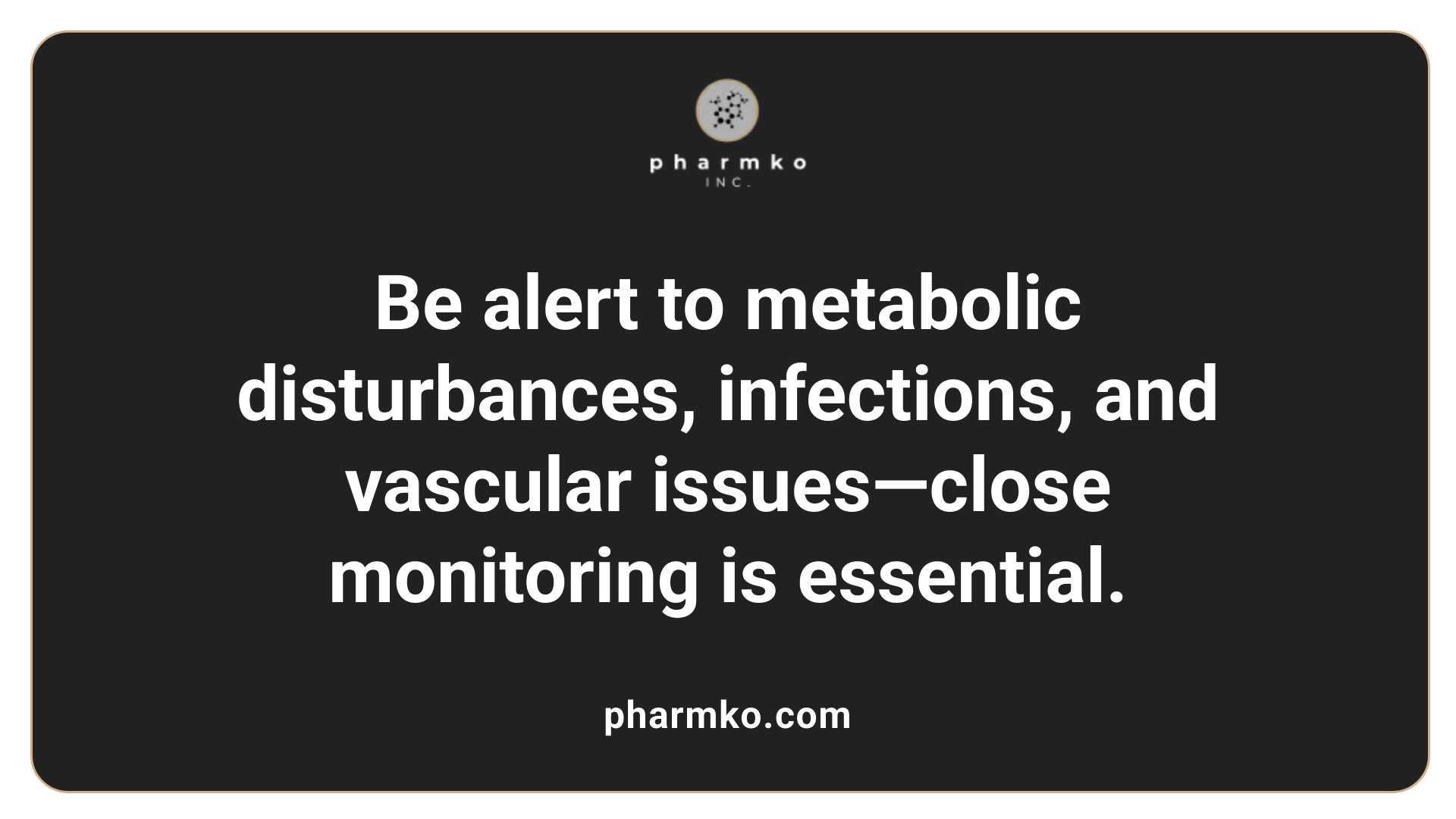 Total parenteral nutrition (TPN) is a valuable nutritional intervention for critically ill patients who cannot tolerate enteral feeding. However, it is not without risks. One of the most common concerns is metabolic abnormalities. Patients receiving TPN may experience fluctuations in blood glucose levels, leading to hyperglycemia or hypoglycemia. Electrolyte imbalances such as hypokalemia, hypophosphatemia, and hypomagnesemia can also occur, which may cause muscle weakness, arrhythmias, or neurological issues.
Total parenteral nutrition (TPN) is a valuable nutritional intervention for critically ill patients who cannot tolerate enteral feeding. However, it is not without risks. One of the most common concerns is metabolic abnormalities. Patients receiving TPN may experience fluctuations in blood glucose levels, leading to hyperglycemia or hypoglycemia. Electrolyte imbalances such as hypokalemia, hypophosphatemia, and hypomagnesemia can also occur, which may cause muscle weakness, arrhythmias, or neurological issues.
Infection risks are significant, especially bloodstream infections caused by contamination or colonization of the IV catheter (central line-associated bloodstream infections—CLABSI). These infections can escalate quickly in critically ill patients, leading to sepsis if not managed promptly.
Venous access complications are another concern with TPN. Catheter-related issues such as thrombosis, vascular injury, or accidental dislodgement are common, requiring careful monitoring and skilled insertion techniques.
Prolonged TPN use can impact liver health. Liver complications like cholestasis, fatty liver disease, and gallstones have been associated with long-term TPN, particularly when caloric intake exceeds needs or when lipid sources are not optimized.
Metabolic bone disease, including osteoporosis, may also develop over extended periods of TPN, especially if micronutrient status is not regularly assessed and corrected.
Other potential risks include refeeding syndrome in severely malnourished patients, which involves severe electrolyte shifts and fluid overload. Catheter-related bleeding, pneumothorax, or vascular injury are additional procedural risks during line placement.
In summary, while TPN can be lifesaving, its administration requires vigilant monitoring to mitigate adverse effects and manage complications effectively.
Contradictions and Precautions in TPN Use During Sepsis
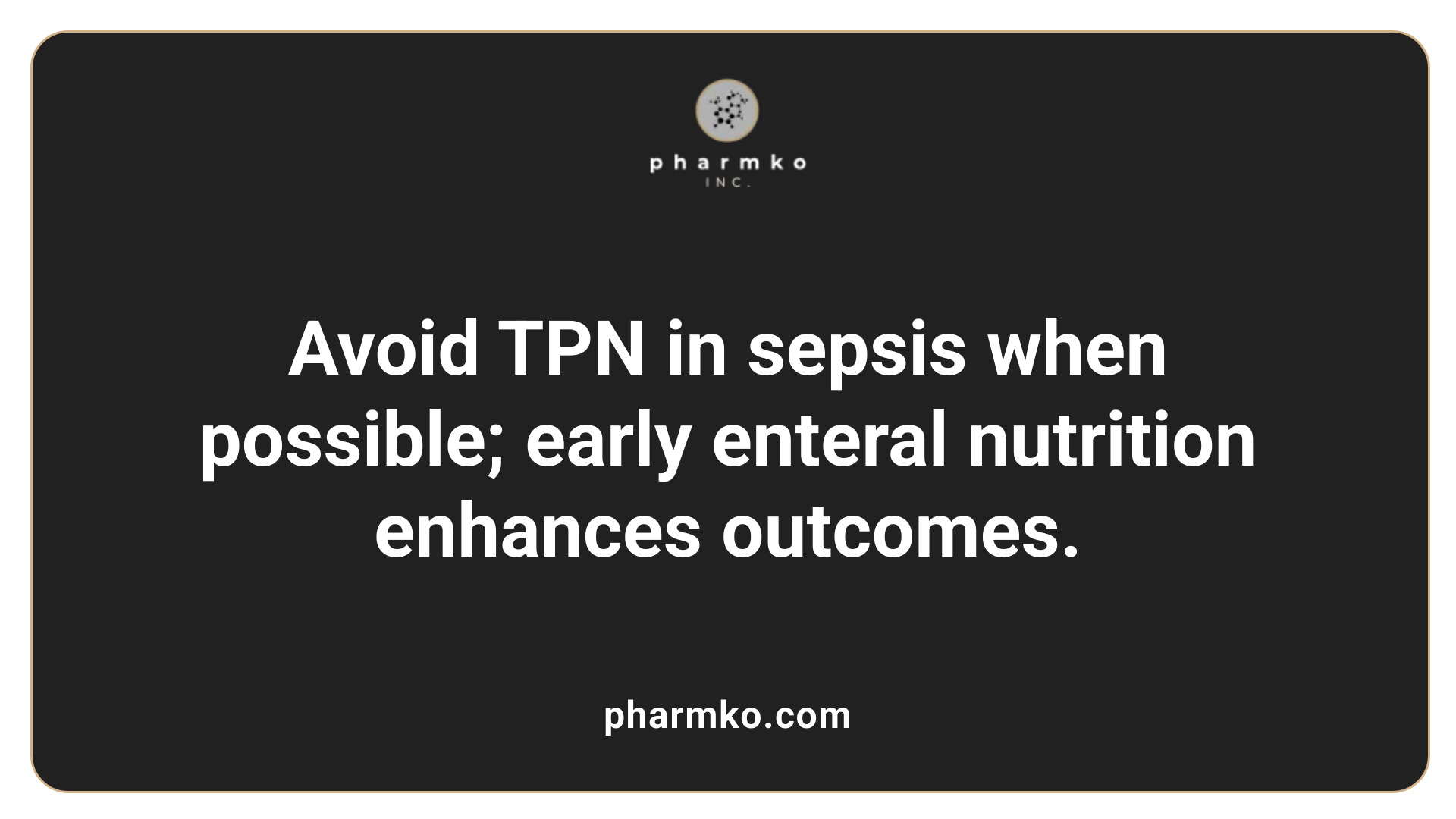
Why is TPN contraindicated in sepsis?
Total parenteral nutrition (TPN) is generally avoided in patients with sepsis because evidence shows it can worsen infection outcomes and increase mortality. TPN has been linked to promoting bacterial translocation—the process where bacteria cross the gut lining into systemic circulation—which can intensify sepsis.
Studies also suggest that TPN can lead to an increase in resistant pathogens, making infections harder to treat. Factors such as prolonged TPN use, central line infections, and excessive caloric intake contribute further to the heightened sepsis risk.
Importantly, TPN-associated sepsis increases patient morbidity and mortality and adds to healthcare costs. Despite earlier beliefs that TPN might cause mucosal atrophy or impair immune responses directly, recent research highlights that the primary concern is its role in fostering bacterial spread and resistant infections.
To reduce risks, clinicians aim to limit the duration of TPN, prioritize early enteral nutrition support, and enforce strict infection control. These measures help maintain gut integrity and immune function, catalyzing better outcomes for septic patients.
| Aspect | Impact/Mechanism | Additional Info |
|---|---|---|
| Sepsis and infection risk | Increases bacterial translocation, resistant pathogens | TPN can inadvertently facilitate bacteria crossing intestinal barriers |
| Morbidity and mortality | Elevated due to worsened infections | Related to the increased bacterial spread and resistant infections |
| Precautionary measures | Early enteral feeding, minimized TPN duration | Promotes gut integrity and reduces infection potential |
Understanding these risks underscores the importance of choosing appropriate nutritional routes in septic patients. Prioritizing enteral nutrition when feasible and limiting TPN duration can significantly improve survival and reduce complications.
Implications of Overfeeding Through TPN in Critical Illness
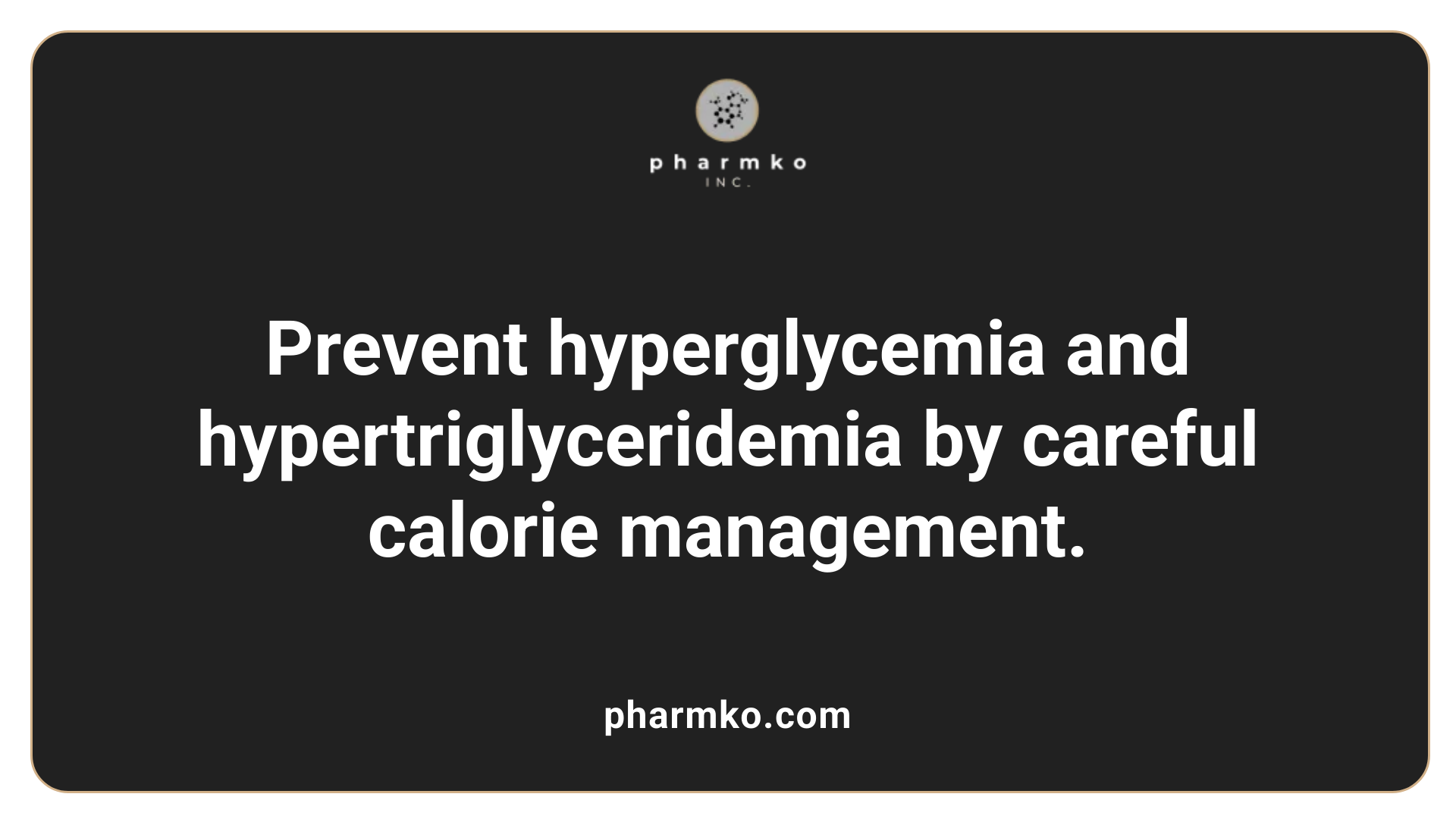 Overfeeding via total parenteral nutrition (TPN) in critically ill patients can have serious metabolic impacts. One of the primary issues is hyperglycemia, which results from excessive carbohydrate infusion, leading to increased insulin requirements and potential diabetic-like complications. Similarly, high levels of triglycerides due to fat overload can cause hypertriglyceridemia, increasing the risk of pancreatitis and systemic inflammatory responses.
Overfeeding via total parenteral nutrition (TPN) in critically ill patients can have serious metabolic impacts. One of the primary issues is hyperglycemia, which results from excessive carbohydrate infusion, leading to increased insulin requirements and potential diabetic-like complications. Similarly, high levels of triglycerides due to fat overload can cause hypertriglyceridemia, increasing the risk of pancreatitis and systemic inflammatory responses.
Fat overload syndrome is another concern, characterized by features like pulmonary edema and hepatosplenomegaly, often driven by excessive lipid infusion. This syndrome can compromise organ function further and complicate recovery.
Overnutrition can also impair immune defenses. Excess nutrients, especially glucose and lipids, heighten oxidative stress and inflammation, undermining immune cell function. This immunosuppression increases the susceptibility to bloodstream infections and sepsis.
Furthermore, overfeeding can cause acid-base disturbances such as metabolic acidosis, and hepatic steatosis due to fatty liver development. The kidney may also be affected, with risks including dehydration and azotemia from excessive protein intake and osmotic effects.
Studies and clinical experiences emphasize the importance of careful monitoring of caloric and nutrient delivery. Routine assessment of blood glucose, triglyceride levels, liver function, and acid-base status helps prevent these complications.
In conclusion, while TPN provides essential nutrients, overfeeding can lead to multiple adverse effects that threaten patient recovery. Tailoring nutritional support to individual needs and closely monitoring metabolic responses are crucial steps in avoiding these dangerous outcomes.
Comparative Effects of Enteral and Parenteral Nutrition on Immune Function
How does enteral nutrition compare to TPN in affecting immune response?
Research has consistently demonstrated that enteral nutrition (EN) plays a crucial role in supporting and maintaining the body's immune defenses more effectively than total parenteral nutrition (TPN). EN nourishes the gut mucosa, promoting its immune functions, by stimulating lymphoid tissue such as Peyer’s patches and M cells. This stimulation leads to the production of secretory Immunoglobulin A (IgA), a vital component of mucosal immunity that acts as a first line of defense against pathogens.
In contrast, TPN, which bypasses the gastrointestinal tract, has been shown to cause considerable declines in cytokine levels like IL-4 and IL-10, and alters the balance of lymphocyte subtypes, notably the CD4:CD8 ratio, thus impairing systemic immune function. Animal studies reveal that TPN significantly reduces intestinal and respiratory secretory IgA levels, weakening the body's nonspecific immune barrier.
Clinical evidence further underscores these findings. Patients receiving EN experience lower rates of respiratory infections and shorter hospital stays, largely due to the preservation of mucosal integrity and systemic immune responses. Conversely, TPN has been associated with increased infection rates and compromised immune parameters.
Overall, EN supports gut mucosal immunity by stimulating mucosal immune components, reducing bacterial translocation, and promoting systemic immune responses. These effects contribute to better clinical outcomes, including fewer infections and enhanced recovery, making EN the preferred approach for nutritional support in critically ill patients whenever feasible.
This comparison highlights the importance of gastrointestinal stimulation in immune health and underscores the benefits of enteral feeding in bolstering immune defenses during critical illness.
Immunonutrition: Supplementation Strategies to Boost Immune Response
What is the evidence for immunonutrition in critically ill patients?
Research supports the use of specific nutrient supplements to enhance the immune response in critically ill patients. Formulas enriched with components such as glutamine, arginine, omega-3 fatty acids, and nucleotides have been shown to reduce infectious complications and improve overall immune function.
Glutamine, in particular, has demonstrated notable benefits. When included in total parenteral nutrition (TPN), glutamine supplementation can increase circulating lymphocytes and T-cell subsets, which are vital for immune defense. It also stimulates T-cell proliferation through IL-2-mediated mechanisms, bolstering the body's capacity to fight infections.
Clinical studies involving ICU patients who received glutamine-enriched TPN reported increased lymphocyte proliferation—measured by stimulation indices and proliferation peak measurements—and enhanced cytokine activity indicated by increased IL-2 production.
Similar positive effects are observed across various patient populations, including those undergoing bone marrow transplants and colorectal cancer surgeries. In these cases, glutamine supplementation led to reductions in infectious complications and potentially lower mortality rates.
Overall, evidence indicates that immunonutrition, especially supplementation with glutamine, supports immune competence, accelerates recovery, and may lead to better clinical outcomes in critically ill patients. Ongoing research continues to refine the optimal formulations and timing for these interventions, emphasizing their role as a promising adjunct to traditional critical care management.
Timing and Route of Nutritional Support: Effects on Immune Parameters and Recovery
How do early and late initiation of TPN affect immune function and clinical outcomes?
Initiating total parenteral nutrition (TPN) early in critically ill patients often results in increased risks without clear mortality benefits. Studies have shown that early TPN, typically started soon after ICU admission, does not significantly decrease death rates compared to delayed or late TPN. However, it is associated with a higher incidence of infections and prolonged stays in the ICU.
Conversely, delaying TPN initiation—usually around day 8—has been linked to better outcomes. Late TPN correlates with fewer infections, shorter durations of mechanical ventilation, and quicker overall recovery. Patients tend to be discharged earlier from ICU and hospital settings.
From an immunological perspective, early enteral nutrition (EN) plays a crucial role in supporting gut mucosal integrity and stimulating immune responses. It enhances the production of secretory immunoglobulin A (IgA), which is vital for preventing bacterial translocation and systemic infections. This immunostimulation helps sustain the body's defense mechanisms during critical illness.
Overall, these findings suggest that a strategic delay in TPN when enteral nutrition is not feasible might help preserve immune function. It promotes better clinical outcomes, reduces complications, and supports faster recovery, highlighting the importance of timing and route of nutritional support in critical care.
The Influence of TPN on Systemic Free Radical Production and Oxidative Stress
Free radical activity in critically ill infants
Critically ill infants receiving total parenteral nutrition (TPN) exhibit a notable increase in free radical activity. Studies in both stable and critically ill infants in the neonatal intensive care unit (NICU) consistently demonstrate that TPN elevates the production of reactive oxygen species, indicating heightened oxidative stress.
Impact of TPN solutions on radical activity
Research suggests that the TPN solution itself may be a source of free radical initiation. This increase in oxidative stress is not significantly mitigated by the addition of minimal enteral feeding, which has minimal impact on radical activity levels. The direct influence of TPN on free radicals underscores the biochemical impact of parenteral nutrition, possibly due to the composition of the solutions or their interaction with immune and cellular pathways.
Potential oxidative stress implications
Elevated free radical activity can cause extensive cellular damage, impairing cell membrane integrity, proteins, and DNA. In critically ill patients, increased oxidative stress from TPN may exacerbate inflammation, worsen organ dysfunction, and delay recovery. The higher radical levels associated with TPN highlight the importance of strategies such as antioxidant supplementation or tailored nutrition formulations to reduce oxidative damage.
| Patient Group | Effect of TPN on Free Radicals | Implications for Patient Care | Additional Notes |
|---|---|---|---|
| Stable infants | Significant elevation in radical activity | Need for monitoring oxidative stress | TPN may directly initiate radicals |
| Critically ill infants | Elevated free radicals linked to TPN | Increased risk of oxidative tissue damage | Radical activity not reduced by enteral feeding |
| Overall | TPN contributes to oxidative stress | Potential mitigation strategies required | Further research needed |
Understanding how TPN influences oxidative stress is crucial for optimizing nutrition in critically ill patients. Balancing caloric and nutrient needs while minimizing potential harms like oxidative damage can improve recovery outcomes and reduce complications.
Summary of Evidence and Clinical Recommendations
What does the current evidence suggest about TPN and immune function in critically ill patients?
Research from multiple sources highlights the complex relationship between parenteral nutrition (PN), particularly total parenteral nutrition (TPN), and immune function in critically ill patients.
Meta-analyses and systematic reviews consistently show that, compared to enteral nutrition (EN), TPN is associated with a higher risk of infectious complications, prolonged ICU stay, and immunosuppression.
Specifically, TPN can cause significant drops in immune signaling molecules such as cytokines IL-4 and IL-10, along with alterations in lymphocyte ratios (like CD4:CD8). It also reduces critical components of mucosal immunity, including secretory IgA levels, which are vital for resisting infections.
Despite these concerns, TPN remains an important option when enteral feeding is contraindicated or insufficient. Current guidelines recommend that when TPN is used, it should be carefully tailored, often supplemented with immunomodulating nutrients like glutamine, arginine, omega-3 fatty acids, and nucleotides. These additions have been shown to enhance immune responses and reduce infectious episodes.
Furthermore, timing plays a crucial role. Early initiation of TPN, especially if not carefully monitored, can exacerbate immune suppression. Evidence suggests that delaying TPN initiation, around day 8 in critically ill adults, allows for better gut integrity and immune function, ultimately leading to fewer infections and better recovery outcomes.
In conclusion, while TPN can be life-saving when nutritional needs cannot be met enterally, the current evidence advocates for cautious use, emphasizing personalized therapy, appropriate timing, and supplementation to support immune defenses and clinical recovery.
Clinical Practice Guidelines and Future Directions
What are the key considerations regarding the safety and potential complications of TPN in critically ill patients?
Managing total parenteral nutrition (TPN) in critically ill patients requires careful attention to its safety profile. While TPN can be life-saving when enteral routes are contraindicated or insufficient, it is associated with several potential risks.
Metabolic disturbances are common concerns, including hyperglycemia, hypoglycemia, electrolyte imbalances, and refeeding syndrome. Hyperglycemia, in particular, can impair immune function and increase infection risk, so blood glucose levels should be closely monitored, targeting levels below 180 mg/dL. Severe metabolic issues might lead to cardiac problems or pancreatitis if not properly managed.
Prolonged TPN use can result in hepatic complications, such as fatty liver, cholestasis, and in some cases, cirrhosis. These complications underline the importance of periodic liver function assessment during therapy.
Furthermore, infectious risks are significant. Central line-associated bloodstream infections (CLABSIs) are a common complication, stemming from catheter-related contamination. Thrombosis and vascular injuries are additional procedural risks associated with catheter placement.
To mitigate these issues, healthcare providers should perform thorough patient assessments, utilize strict aseptic techniques when inserting and maintaining catheters, and tailor nutritional formulas to individual needs. Routine laboratory monitoring, including blood glucose, liver enzymes, electrolytes, and triglycerides, is essential for early detection of complications and timely adjustments.
In recent research, energy expenditure measurement via indirect calorimetry has improved PN safety and effectiveness, especially when used to guide caloric provision. Lipid composition also influences immune response and hepatic function, with specialized emulsions showing promise in reducing infection and liver-related issues.
Overall, personalized approaches, vigilant monitoring, and adherence to evolving guidelines are vital for optimizing TPN safety and outcomes in critically ill patients.
Balancing Benefits and Risks of TPN in Critical Care
While TPN remains an essential nutritional modality for critically ill patients, its impact on immune function and potential for complications necessitate careful, individualized application. Optimizing timing, composition, and route—favoring enteral nutrition when feasible—can enhance immune responses, reduce infection risks, and improve clinical outcomes. Future research should focus on refining immunonutrition strategies and establishing clear protocols to maximize TPN benefits while minimizing adverse effects, ultimately advancing the standards of critical care nutrition.
References
- Parenteral Nutrition in the Critically Ill Patient - PMC - PubMed Central
- Enteral nutrition and mucosal immunity: implications for feeding ...
- The effect of critical illness, parenteral nutrition, and enteral feeding
- Effect of combined parenteral and enteral nutrition versus... - LWW
- Enteral glutamine feeding and some aspects of immune function in ...
- Effect of total parenteral nutrition or early enteral ... - ResearchGate
- Nutritional Intervention in Critical Care | Respiratory Therapy
- Optimising healing through enteral and parenteral nutrition in critical ...
- Is Total Parenteral Nutrition (TPN) an Evil in Trauma Patients?
- Enteral versus parenteral nutrition in critically ill patients - Critical Care













